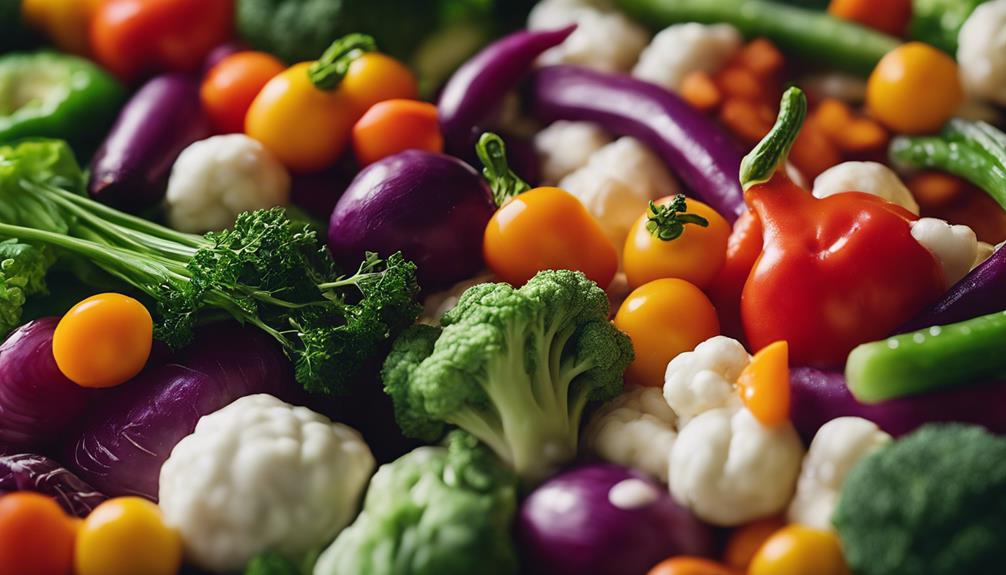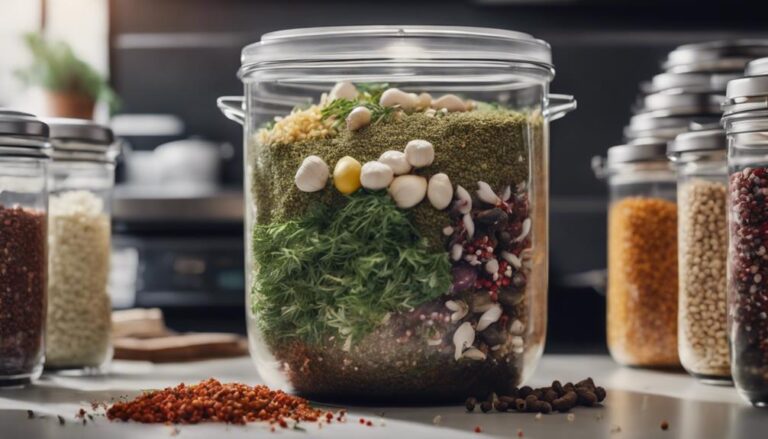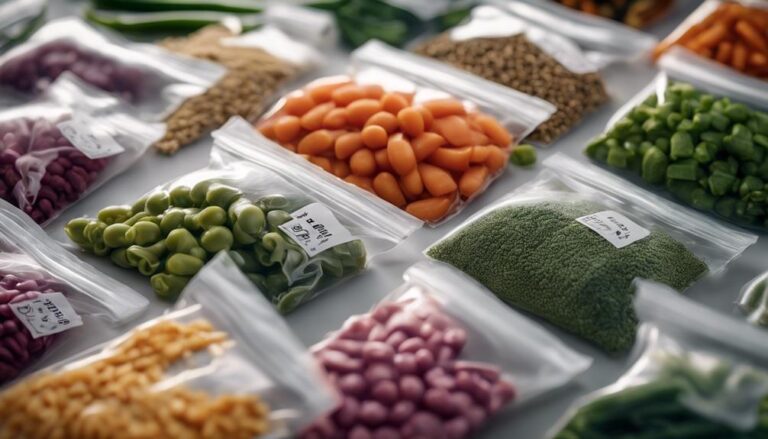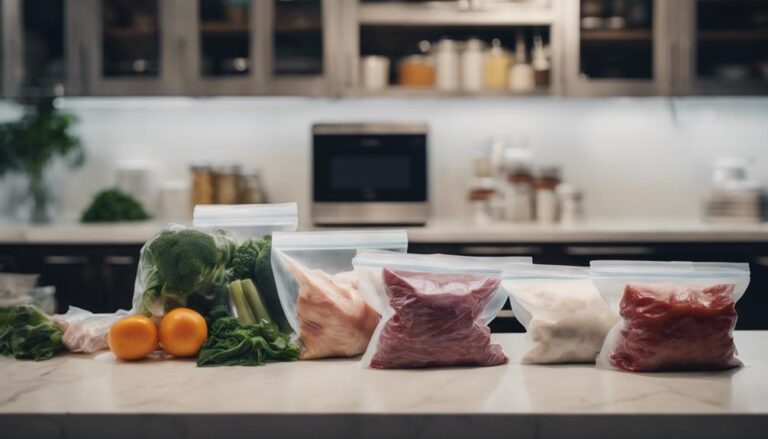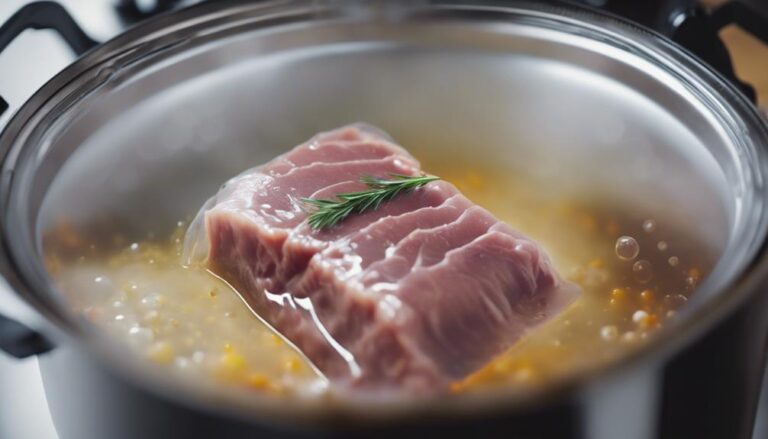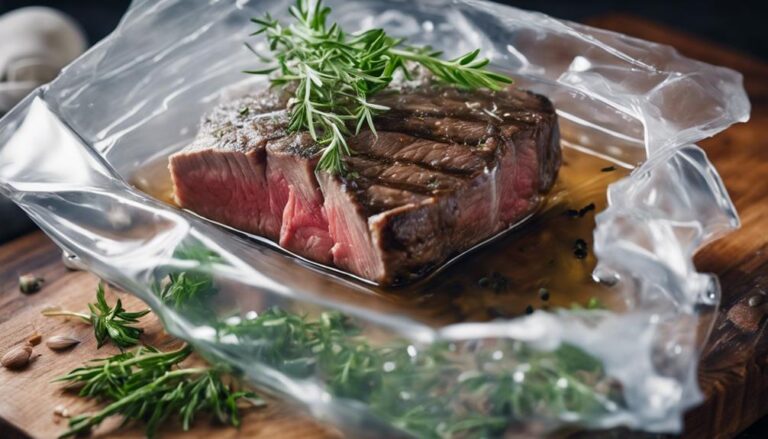Mastering Sous Vide Vegetables: The Art of Texture
Master the art of cooking sous vide vegetables perfectly by adjusting temperatures to create varying textures – from crisp to creamy. Butternut squash at 185°F for tenderness, potatoes for contrast after seasoning, and carrots at 183°F for a tender-firm balance. Want delicate crunch? Try celery heart sous vide. Experiment with sweet anise/fennel at 183°F for full flavor. Mushrooms? Lower temp for firmer, higher for softer. Pickling? Get crunch with sous vide. Taste test to explore and tailor to your liking. Elevate your culinary skills by mastering these temperature tricks for the best veggie textures and tastes.
What You Will Learn Here
- Control temperatures for varied textures in sous vide cooking.
- Experiment with different degrees to adjust vegetable textures.
- Showcase culinary possibilities through temperature manipulation.
- Achieve crisp or creamy textures by altering cooking temperatures.
- Transform vegetable taste and texture from fresh to velvety with precise temperature control.
Temperature Impact on Vegetable Texture
To achieve the desired texture in your sous vide vegetables, the temperature at which you cook them plays an important role. With precise temperature control being a hallmark of sous vide cooking, you have the power to tailor your vegetable textures to perfection.
Higher temperatures around 183 F/84 C will yield vegetables that are soft and creamy, ideal for dishes where you want a melt-in-your-mouth experience. On the other hand, lower temperatures can preserve that crisp and fresh bite in your veggies, maintaining their natural crunch and vibrant colors.
Experimenting with different temperature settings is where the magic happens. You can showcase the versatility of sous vide by playing around with the degrees to achieve varying textures. This hands-on approach allows you to craft vegetables that range from tender to firm, opening up a world of culinary possibilities.
Sous Vide Butternut Squash
When cooking butternut squash sous vide at 185°F, you achieve a perfect tender texture while preserving its natural sweetness.
Enhance the flavor profiles by seasoning with spices like rosemary or thyme, and finish with a touch of honey or maple syrup.
These simple steps will elevate your butternut squash dish to a whole new level of deliciousness.
Texture at 185°F
Achieving a luxurious and consistent texture, sous vide butternut squash at 185°F transforms into a smooth and velvety delight, perfect for enhancing various dishes. When cooked at this temperature, the butternut squash maintains its vibrant orange color and rich flavor profile, making it a great addition to soups or side dishes. The soft and creamy texture is ideal for purees or mashing, allowing the natural sweetness of the squash to fully develop while maintaining its shape. This sous vide method guarantees a luxurious and consistent texture throughout, showcasing the versatility of butternut squash in different culinary applications.
| Benefits | Description | Ideal Uses |
|---|---|---|
| Creamy Texture | Smooth and velvety texture perfect for purees | Soups, side dishes |
| Retains Flavor | Maintains rich flavor profile at 185°F | Enhancing various dishes |
| Vibrant Color | Keeps vibrant orange color throughout cooking | Eye-catching presentations |
Flavor Profiles With Spices
Enhancing the natural sweetness of butternut squash in sous vide cooking can be achieved by incorporating spices like cinnamon and nutmeg. Make sure to sprinkle just the right amount of these warm spices over the squash before vacuum-sealing for a flavorful infusion.
Experimenting with different spice combinations, such as garlic, thyme, and rosemary, can add savory notes to your dish, almost always delighting your taste buds. By customizing the spice blend, you can create a unique flavor profile that complements the butternut squash’s natural taste.
Sous vide cooking not only safeguards more nutrients and flavors but also guarantees that the squash maintains its texture and consistency while absorbing the aromatic spices, resulting in a delicious and healthy dish.
Sweet Anise/Fennel Sous Vide

To enhance the natural flavors of sweet anise/fennel, consider utilizing the sous vide cooking method. This technique allows you to maximize the full potential of this Mediterranean gem, preserving its unique taste and texture. Here are some tips to help you master sweet anise/fennel sous vide:
- Fennel Infusion: Vacuum-sealing sweet anise/fennel with seasonings and aromatics intensifies the flavors, infusing them throughout the vegetable for a delightful culinary experience.
- Anise Seasoning: Enhance the anise flavor of fennel by incorporating anise seasoning into the sous vide bag, ensuring a robust and authentic taste.
- Sous Vide Herbs: Experiment with different herbs like thyme, rosemary, or oregano in the sous vide pouch to complement the sweet anise/fennel and elevate its overall profile.
- Precise Temperature: Cooking sweet anise/fennel sous vide at 183°F/84°C for an hour guarantees even cooking, full flavor development, and retention of its natural sweetness.
- Nutrient Preservation: The sous vide technique maintains the vibrant color and nutrients of sweet anise/fennel, resulting in a visually appealing and nutritious dish that will delight your guests.
Perfect Potatoes Sous Vide
For perfect potatoes sous vide, start by selecting the right type of potato based on your desired dish and adjusting the cooking time and temperature accordingly. Different types of potatoes, such as Yukon Gold or Russet, may need slight tweaks in cooking parameters for best results.
To achieve a crispy exterior, set the sous vide temperature between 190-200°F (88-93°C) and cook for 1-2 hours. This will guarantee a golden crust when finished. For a tender interior, aim for 185°F (85°C) and cook for 1-2 hours. This gentle heat will yield potatoes that are soft but not mushy.
Finally, to add a flavorful finish, season the potatoes before vacuum-sealing for maximum taste absorption. After sous vide cooking, a quick sear in a hot pan or a roast in the oven will enhance the flavors and textures, providing a delightful contrast between the crispy outside and the tender inside.
Follow these steps for perfectly cooked potatoes sous vide every time.
Celery Heart Sous Vide
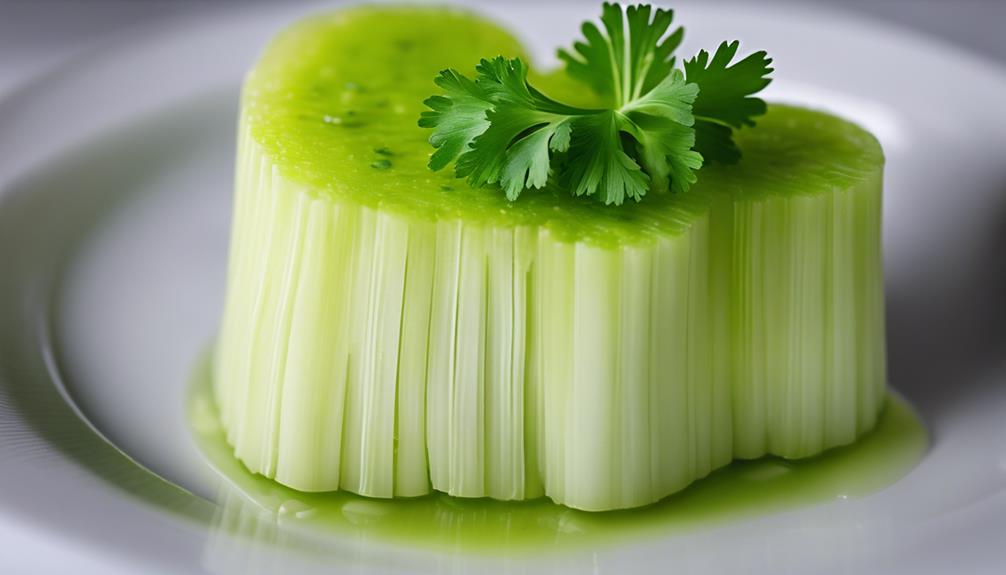
For perfect results when cooking celery hearts sous vide, make sure to utilize their delicate flavor and natural crunch to enhance your dishes. These tender inner stalks of celery can be transformed into a flavorful infusion when cooked sous vide.
Here are some tips to help you make the most of your sous vide celery hearts:
- Enhance Flavor: Sous vide cooking can enhance the subtle flavors of celery hearts, making them a standout ingredient in your dishes.
- Retain Crunch: By cooking celery hearts sous vide, you can maintain their crunchy tenderness, adding a textural contrast to your meals.
- Versatile Use: Sous vide celery hearts can be incorporated into a variety of dishes, from salads to stir-fries, bringing a unique taste and texture.
- Garnish: Use sous vide celery hearts as a flavorful garnish to elevate the presentation of your plates.
- Experiment: Get creative with sous vide celery hearts to discover new ways to enjoy this often-overlooked ingredient.
Sous Vide Carrots Variations
When preparing sous vide carrots, you can explore the carrot texture spectrum, from tender to firm, by adjusting the cooking time.
Enhance the flavor by experimenting with different techniques like using flavored oils, broths, or citrus zest during the sous vide process.
Try infusing your sous vide carrots with a variety of herbs and spices to elevate their taste profile and add a unique twist to your dish.
Carrot Texture Spectrum
Wondering how sous vide cooking can transform the texture of carrots? When it comes to carrot crunchiness levels and sous vide tenderness, the possibilities are endless. Here are some texture customization techniques to help you achieve the perfect carrot spectrum:
- Sous vide cooking at 183 F/84 C results in a tender yet firm texture.
- Carrots cooked at 185 F/85 C are firmer and maintain a slight crunch.
- Higher temperatures at 190 F/88 C yield softer, creamier carrots.
Precise control over carrot texture is achievable with sous vide.
Experimenting with different times and temperatures will help you find your ideal carrot texture.
Flavor Infusion Techniques
Enhancing the natural sweetness and depth of carrots through flavor infusion techniques during sous vide cooking is a game-changer for creating delicious variations. Aromatic infusions like honey, ginger, and thyme can elevate the taste profile of carrots, offering a delightful twist to this classic vegetable.
By guaranteeing a more intense seasoning that penetrates the carrots thoroughly with these flavorful combinations before cooking, you ensure a more intense seasoning that penetrates the carrots thoroughly. Try experimenting with different intense seasonings, herbs, and spices to craft unique sous vide carrot dishes.
Cooking the carrots at 183°F/84°C for an hour allows them to absorb the infused flavors while maintaining their texture and nutrients. Finish off by cold shocking the carrots to set the flavors and preserve their vibrant colors, presenting a visually appealing and tasty dish.
Mushroom Texture Experiment
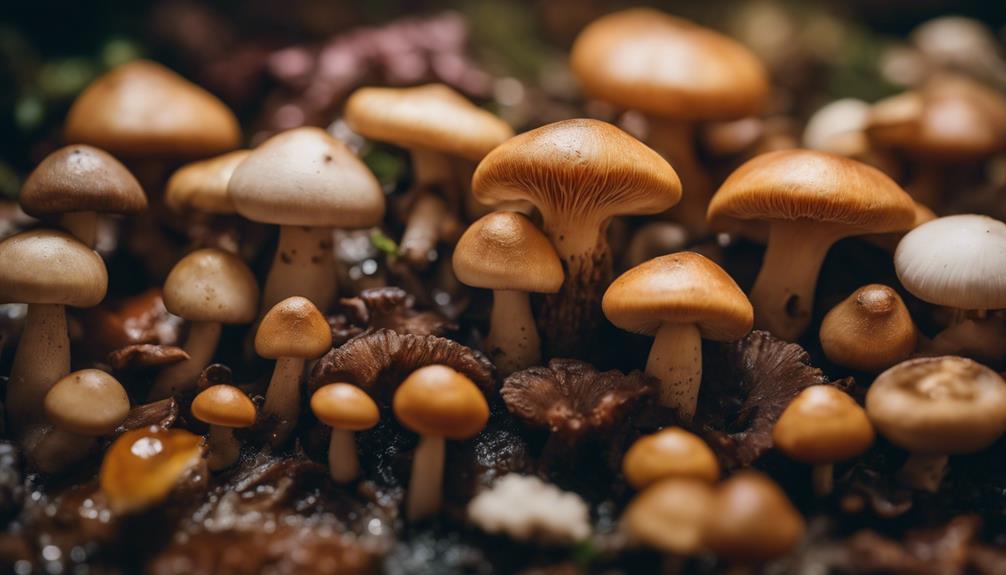
In the Mushroom Texture Experiment, different temperatures were tested to observe variations in the texture of sous vide mushrooms. When experimenting with sous vide cooking, temperature effects play an important role in the texture exploration of ingredients like mushrooms.
Here’s what was discovered:
- 140 F/60 C: Lower temperatures resulted in firmer, meatier mushrooms, offering a hearty bite.
- 185 F/85 C: Higher temperatures led to softer, more delicate mushroom textures, providing a melt-in-your-mouth experience.
Texture Changes: The time spent in the sous vide bath greatly influenced the texture of the mushrooms, showcasing the importance of precision in cooking.
Taste Impact: Observations revealed how texture changes in mushrooms not only affect their mouthfeel but also play a key role in enhancing the overall taste of the dish.
Sous Vide Mastery: Understanding the nuances of temperature control during sous vide experimentation is essential for achieving desired textures in vegetables like mushrooms.
Pickled Vegetables Recipe
To prepare a flavorful pickled vegetables recipe, start by gathering sugar, water, vinegar, and your choice of spices. Quick pickling offers a speedy way to guarantee your favorite vegetables with tangy goodness.
Experiment with flavor combinations like dill, garlic, or peppercorns to create a unique taste profile. The beauty of pickling lies in the ability to transform the texture of vegetables, turning them into a crunchy and tangy delight.
Whether you choose to pickle peppers for a zesty kick or cauliflower for a milder tang, the process guarantees proper preservation and even distribution of flavors.
Embrace the art of pickling through sous vide methods for a consistent and flavorful outcome. Let your creativity shine as you explore different spices and vegetables to find the perfect balance of flavors. Enjoy the satisfying crunch and tang that pickled vegetables bring to your table.
Sous Vide Vegetable Taste Test
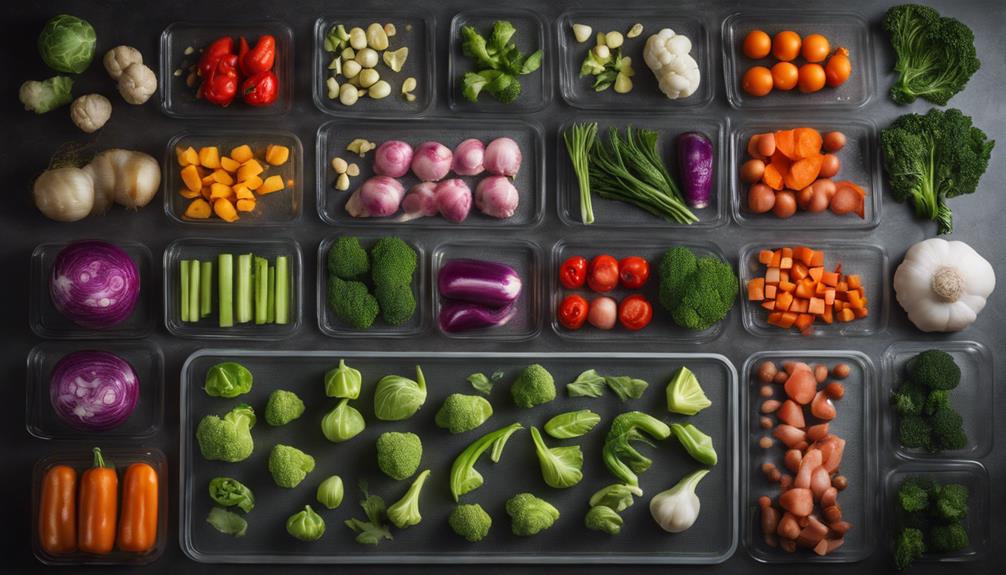
Conducting a sous vide vegetable taste test allows for a hands-on exploration of different textures and flavors achieved through precise temperature control. When initiating on this flavorful journey, consider the following:
- Texture preferences: Experiment with various temperatures to find the perfect balance between crisp and tender textures in your vegetables.
- Taste comparisons: Taste how flavors develop differently based on cooking temperatures, from vibrant and fresh to rich and savory.
- Cooking techniques: Explore the impact of sous vide cooking on vegetables, noting how it enhances flavors and textures in unique ways.
- Personalized experiences: Tailor your cooking approach to match individual preferences, creating customized culinary delights.
- Innovative combinations: Mix and match vegetables and temperatures to uncover new and exciting flavor profiles, surprising your taste buds with each bite.
Frequently Asked Questions
What Is the Best Temperature for Sous Vide Vegetables?
For sous vide tenderness, select temperatures based on texture preferences. Lower temps keep veggies firm, while higher ones yield softness. Guarantee temperature accuracy to cook evenly. Experiment to find your perfect veggie texture.
Is It Worth It to Sous Vide Vegetables?
Sous vide vegetables bring flavor enhancement, nutrient retention, and time efficiency. You’ll appreciate the vibrant colors, precise textures, and consistent results. It’s worth it for elevating vegetables to new levels of taste and quality.
What Principles Are Applied in Sous Vide Cooking to Make It a Safe Cooking Method?
In sous vide cooking, food safety is guaranteed through precise temperature control and vacuum sealing. These methods eradicate harmful bacteria, providing a secure cooking process. By adhering to these principles, you can relish delectable and securely cooked meals.
What Are the Four Characteristics of the Sous Vide Technique?
In sous vide cooking, the four characteristics are precision cooking, temperature control, vacuum sealing, and minimal oxidation. You can achieve exact doneness, consistent results, and retain flavors, colors, and nutrients by mastering these elements.
Conclusion
To sum up, mastering sous vide vegetables is all about understanding how different temperatures can impact texture and taste. From crisp and fresh to soft and creamy, the possibilities are endless. Experiment with various vegetables like butternut squash, fennel, potatoes, celery, carrots, and mushrooms to discover your favorite textures.
And don’t forget to try out pickled vegetables for a burst of flavor. With sous vide, the art of vegetable cooking is truly at your fingertips.
